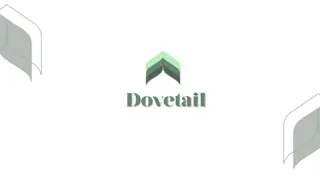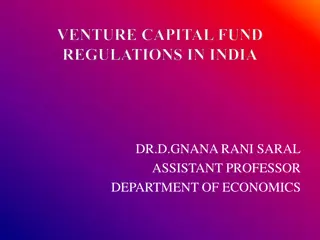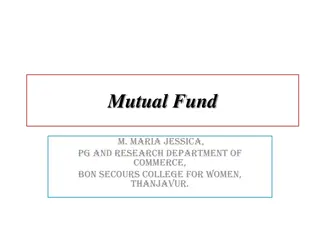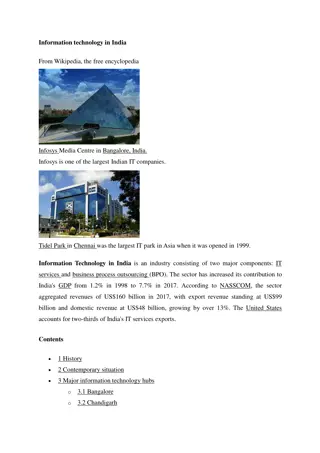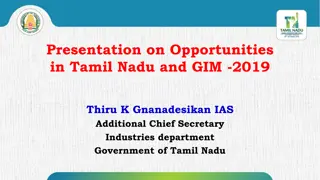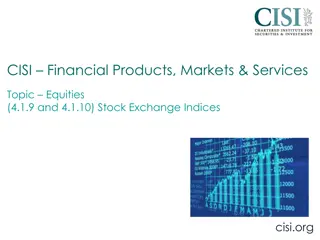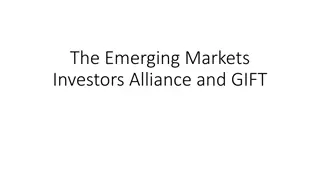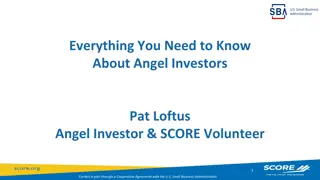Understanding Industry Attractiveness for Investors in India
This presentation explores the factors that make a business appealing to investors, including market characteristics, pricing trends, and competition intensity. It discusses how investors' risk appetite, value perception, investment time horizon, and past experiences influence their decision-making. The analysis considers factors like market size, growth rate, pricing trends, and barriers to entry to assess industry attractiveness for potential investors.
Download Presentation

Please find below an Image/Link to download the presentation.
The content on the website is provided AS IS for your information and personal use only. It may not be sold, licensed, or shared on other websites without obtaining consent from the author. Download presentation by click this link. If you encounter any issues during the download, it is possible that the publisher has removed the file from their server.
E N D
Presentation Transcript
Institute of Actuaries of India Capital infusion Is the business appealing enough to attract investors? Vichitra Malhotra Gopal Kumar Ishwar Gopashetti Guide: Mayur Ankolekar Indian Actuarial Profession Serving the Cause of Public Interest
Agenda Introduction Industry Analysis General Insurance Life Insurance E-Commerce Summary Questions 2
Introduction - Appeal to Investors What makes a business appealing for Investors? From purely economic view point, business which earns highest return risk adjusted compared investment opportunities (opportunity cost) to other is investors. most appealing to 3
Introduction Appeal to investors Business Appealing also depends on investors RISK APPETITE & VALUE Business Appealing or Not ? INVESTMENT TIME HORIZON & PAST EXPERIENCE SURPLUS CAPITAL & OPPORTUNITY COST 4
Introduction Industry attractiveness Determining if the option at hand is the best depends on various factors: Factor Potential/Attractive Challenge/Unattractive Market Characteristics Market Size Large potential Small disparate market Market growth rate Growing and will continue to grow Growing slowly, flat or declining Holding steady and moving with inflation Prices falling and becoming more competitive Pricing trends Changes in cost passed on to customer, profitability maintained Margins sinking and pressure to squeeze out cost Profitability trends Direct Industry Forces Intensity of direct competition Market dominated by few players with high market share Fragmented with no competitor Customer purchasing power Plenty of customers and low dependency on any one customer Few dominant customers with long term supply contracts Potential for Innovation, Intellectual Property (IP) rights protection Product Innovation Standardized Products 5
Introduction Industry attractiveness Factor Potential/Attractive Challenge/Unattractive Other Forces Intensity of direct competition from substitution Plenty of alternative ways to deliver the product or service benefit No significant or viable alternatives High barriers to entry deterring new entrants Barriers to entry Low barriers to entry Plenty of suppliers with over supply and few of them have significant marker share Supplier / distributor dominance Few suppliers Collaborative environment between Regulator and Industry members Restrictive environment Uncertainty of the future Regulatory environment 6
Introduction Industry attractiveness Alternative analysis 7
Introduction Industry valuation Perpetuity Valuation Actual cash flow for return capitalisation Actual profit for return capitalisaiton Problems: Appropriate return On which to make A valuation (Basis: return expectation of Independent Measure Discounted cash flows Future cash flows Future Profit Future dividend payments Net asset value Net assets Liquidation value Buyer Performance Multiples EBITDA multiple Earnings multiple Cash flow multiple Revenue multiple Availability of Comparable data Data of market / industry Comparative Measure (Basis: comparable P/E growth multiples Net asset value Book value multiple Problems: ) Current Value Measure Problem Future Oriented Measure Problem 8 Buying the future and not the past Forecast accuracy
GI Industry Growth & Market Size Significant top line growth EXPECTED TO CONTINUE IN FUTURE From a Rs 12,000 crore top-line industry in 2001 02, today it is worth 70,000 crore, clocking an annual growth rate of 17% over the last decade. The industry today provides a cover of Rs 1,000 lakh crore. GI penetration still on the lower side. Projected Growth of GI Industry (GWP in Rs. 000 Cr) GI Industry, with low startup capital, is projected to grow at 16% in medium to long term mainly on account of economic growth, socio economic drivers penetration. 193.8 16% 145.9 109.4 81.2 57.9 and greater FY 12 FY 14 FY 16 FY 18 FY 20 Source: KPMG Analysis, IRDA Annual Report 2012 9
GI Industry Profitability (low and fluctuating) Profitability low driven by intense competition and regulated Motor TP prices. De-tariffication has resulted in prices being cut significantly. Combined Operating ratio - 2011-12 140% Expenses Claims 35% 105% 16% 23% 20% 33% 30% 29% 70% 34% 88% 80% 76% 75% 35% 67% 64% 61% 53% 0% US Germany UK Indonesia South Africa China Malaysia India 10
GI Industry Regulatory update Creation of Indian Motor Third Party Insurance Pool KeyRegulatory Introduction of declined risk pool, TP premium rates increase Changes New health insurance guidelines introduced Merger and Acquisition Guidelines Price Detariffication 2007 2011 2012 2013 Change in Industry Mechanism to equitably share CVTP losses Enabled consolidations, inorganic transactions in the industry Improvement in overall profitability of the CV segment Streamlining of products Significant change in premium rates for commercial lines 12
GI Industry - Challenges Product Innovation Existing products mainly standardized Some innovation seen in terms of add on benefits and customized products to some segments Lack of proper customer segmentation with products for complete customer life cycle Nature of Competition Many new entrants seen since 2007 Focus on growth and competition only on price Third Party Premium Rates Limited or no increase in TP premium rates Third Part liability caps under Motor Vehicles Act Liability generally decided through court orders; high claim ratios 13
GI Industry - Challenges Distribution Models Mainly Agents & Brokers (60% of industry premium) Agents: High churn out, low productivity and low customer connect Brokers: Fragmented, unable to offer full range of services to customers Bancassurance potential not utilized fully Pricing Challenges Potential for using risk based pricing, capturing data through new technologies (big data etc.) not exploited enough. Need for having separate pricing approach for each line 14
GI Industry - Future prospects Industry has huge potential; but initiatives needed to exploit full potential and grow irrespective of economic environment Competition of Product Differentiation versus Price Differentiation Better customer segmentation to meet needs across life cycle; Product innovation need of hour. Invest in building best in class claims management Strengthen pricing mechanisms; Talent development Strengthen distribution model to maximise reach; Power of E-distribution and shared services should be leveraged 15
The Life Insurance Industry - evolution Birla Sun Life Bajaj Allianz Aviva Sahara Life Shriram Life Bharti AXA IDBI Federal Aegon Religare India First Edelweiss Tokio HDFC Life Exide Life Future Generali Canara HSBC OBC Total Premium INR 3,13,000 Cr* ICICI Prudential Kotak Life DHFL Pramerica Max Life PNB MetLife Star Union Dai-chi Reliance Life SBI Life Tata AIA Total Premium INR 35,000 Cr Wave 1 Wave 2 2001 2002 2003 2004 2005 2006 2007 2008 2009 2010 2011 2012 2013 2014 Source: IRDA Bank-led: ICICI Prudential, HDFC Life, Kotak Life, Exide life, SBI Life, PNB MetLife Non bank-led: Birla Sunlife, Max Life, Bajaj Allianz, Reliance Life, Tata AIA, Aviva, Sahara Life, Shriram Life Wave 1 Bank-led: IDBI Federal, Canara HSBC OBC, Star union Dai-chi Life, India First Non bank-led: Bharti AXA, Future Generali, Aegon Religare, DHFL Pramerica, Edelweiss Tokio Wave 2 16
The regulatory changes overview Key guidelines a ULIP regulations (FY11) Guidelines on pension products (FY12) Linked and Non-linked products regulations (FY13) Increased lock-in period for ULIPs from 3 years to 5 years, Scrapped the 4.5% guaranteed annual return clause on ULIP pension Minimum death benefit specifications for single and regular premium products Age based minimum mortality cover at ~ 10 times premium However, all pension products to have a guarantee of a non-zero rate of return Minimum premium payment term of 5 years for non-single premium policies Caps on surrender charges Company that contracts the original deferred pension policy is required to provide the annuity product to the policyholder Cap on reduction in yield basis policy term Cap on commission basis premium payment term Pension to offer a minimum 4.5% p.a. guarantee Industry-wide impact No Pension products available for sale for a long time. Hence, decline in new business. Re-pricing of products Reduction in commission Reduction in margin and loadings leading to downsizing of Agency Reduced commission reduced new business 17
Appraisal Value What are the drivers? Structural Value Embedded Value Business Mix Future / Expected Profit Margin Future Growth Rate Acquisition Expense Overrun Risk Discount Rate AV Actual Expenses Persistency Miscellaneous Structural Value 18
Value Creation Framework Business Value = VNB * Multiplier + EV VNB = FYP X VNB Margins Multiplier Embedded Value First Year Premium Distribution Network Product Brand Future Growth Loyalty / Trust Distributors Customer / Referral/Cross Sell Product Mix Expense Management Claims Management VNB Margins Product Innovation Product Mix Risk Management Practices Mortality / Morbidity Investments Brand and Marketing Diversification Product Distribution Persistency management Policy Premium Withdrawals Continued excellence Corporate Governance Compliance Quality and Scalability Loyal employee Investment Performance Pricing Power Risk management 19
Life Insurance: Industry Analysis MACRO ANALYSIS Market Characteristics - Market Size Direct Forces - Market Growth rate - Intensity of competition - Pricing trends - Customer purchasing power - Profitability Trends Industry Attractiveness Limiting Forces Others - Substitute products - Regulatory reforms - Barriers to entry - Political and economic environment - Distributor dominance - Regulatory restriction 20
Future Outlook Potential - Market Size - $ 1 trillion by 2020, - Market Growth rate 12 % to 15% pa Reason - Favorable demographics Insurable population 75 Crores lives, Average Age 27, - Increased consumer awareness - Insurance premium % of Domestic savings 35% by 2020 from 26% in 2010 - Leveraging Digital Platform to tap into the target market Challenges - Stable regulatory environment - Cost effective distribution channel - Untapped potential Digital space - Product innovation 21
Industry Analysis RATIO ANALYSIS Operating performance / Profitability Liquidity test - Benefits paid to premium written - Quick Liquidity (Cash + ST Investment) to total investments, - Commission and expenses to Premium Corporate Governance Current Liquidity Current Assets to total liabilities, - Return on invested assets Risk Management - NBAP Margin - Industry Attractiveness Business Profile Balance sheet strength - Spread of risk - Net Worth, - Revenue composition - Solvency ratio, - Competitive market position - Total capital and surplus to total liabilities - Management - Insurance market risk 22
Industry Trend: Private Players vs. LIC Expense Ratio - Private Players Expense Ratio = OPEX / Premium Income Other measures also followed ex. OPEX to FYP 310% 260% 210% Ratio 160% 110% 60% Adjusted Opex Ratio = OPEX / (Premium Income + Investment Income - Increase Reserve) 10% FY 02 FY 03 FY 04 FY 05 FY 06 FY 07 FY 08 FY 09 FY10 FY11 FY12 FY13 Financial Year Ending Opex Ratio Adjusted Opex Ratio OPEX Ratio China 8.3% UK 4.8% Singapore 6.9% Expense Ratios - LIC 13.0% 11.0% 9.0% Ratio 7.0% 5.0% 3.0% 1.0% FY 02 FY 03 FY 04 FY 05 FY 06 FY 07 FY 08 FY 09 FY10 FY11 FY12 FY13 Financial Year Ending Opex Ratio Adjusted Opex Ratio 23
NBAP Margins Participating products ULIPs Term insurance 50% 40% 10-12% 6-9% 15-20% 4-8% 40-60% 40-60%* 30% 20% New Business margins 10% 0% Pre 2010 Current Pre 2010 Current Pre 2010 Current 50% 40% 2-4% 1-3% 3-5% 0.5-2% 12-15% 12-15%* 30% Profit margins 20% 10% 0% Pre 2010 Current Pre 2010 Current Pre 2010 Current *For non-online term policies Based on analysis & industry discussions New Business Margin = PV of Distributable earnings / Annualised First year premium Profit Margin = PV of distributable earnings /PV of premiums 24
Comparative Statistics: Transactions & public Disclosures Category/Company HDFC Life Max Life Reliance Life Aviva Life Exide Life Basis Year MCEV Mar-13 EEV Mar-12 TEV Mar-11 TEV Dec-13 TEV Mar-13 EV- Before Overrun 6,020 3,786 2,730 1,800 844 Net Worth VIF 1,690 4,330 1,711 2,075 439 2,291 697 1,103 339 505 Overruns 150 102 NA NA NA EV - after overrun 5,870 3,684 2,730 1,800 844 NB-Profits 584 168 340 60 89 NB Margins AV Good will NBM AV/EV 17.80% 13,000 7,130 12 2.21 17.80% 10,504 6,820 41 2.85 12.80% 11,500 8,770 26 4.21 14.00% 5,000 3,200 53 2.78 14.00% 1,100 256 3 1.3 2,160 2,127 3,094 2,005 1,465 Capital Infused The numbers of Max Life, Reliance Life and Exide Life are as per the transactions HDFC Life numbers (EV) are published as a part of the Investor Presentation. AV is based on bankers publication The numbers of Aviva Life are as per the article published in the Economic Times The details of capital infused and net worth are obtained from the financials disclosed in the public disclosures for each of the companies. 25
PE Multiple Comparison for Life Companies GW Good Will (Market Value less EV) EV Does not include the expense overrun l 26
E-commerce Industry: Introduction E-commerce Industry on a roller coaster ride over the last five years Picked up in 2011 and continued thereafter Internet penetration in India has been increasing exponentially 21 million in 2006 to 243 million users by June 2014. Number of active mobile internet users grown to 185 million. India s ecommerce market at $10- 16 billion last year, annual increase of 88% and by 2020 it could be 60-80 billion. 27
Investment Opportunity or Bubble? Opportunity: Growing sector in India; Emerging sector, in long term at least 10 per cent of Indian retail will move to online. Bubble: High gestation period, difficult to sustain losses, only top-line driven, bottom line not in sight. If you have a long term view and if you are cash surplus, then you can jump in and others who are not cash surplus and don't take a long term view, it probably will look like a bubble. 28
Capital Infusion: Investors Rationale Sector to reach $32 billion (Rs 1.9 lakh crore) in 2020 Investors pumped in over $1.6 billion (Rs 9,700 crore) across 24 deals so far in 2014 vs $553 million (over Rs 3,300 crore) in 2013 across 36 deals. PE funds typically value companies on profitability and cash flow, while VCs value companies on multiple of sales E-Commerce in India cam a long way when eBay started its operations in India in 2004 by acquiring Baazee.com. 29
Top Capital Infusions in the Sector Amazon - $2 billion investment in India Flipkart - raised $1 billion from Tiger Global Management and Naspers. Snapdeal - SoftBank Internet and Media, committed $627 million Myntra- $50 million by Premji & others Bigbasket - $33 million from Helion Ventures and others Jabong - secured $27.5 million from British development finance institution Urbanladder - $21 million from Steadview Capital and others Firstcry - $15 million funding from Vertex Venture Management 30
Valuation Game Valuation is subjective Valuations depends on many qualitative and quantitative parameters. At this stage less of quantitative and more of qualitative parameters Depends on perception of potential and share of success in past (Softbank Alibaba) Investors feel not investing in e-commerce may prove to be a lost opportunity 31
Summary Life Insurance General Insurance E commerce Market Characteristics Market Size Large Potential Large Potential Large Potential Market growth rate Growing slowly, flat or declining Growing at steady rate Exponential Growth Pricing trends Prices falling and becoming more competitive Competitive Competitive Profitability trends Margins sinking and pressure to squeeze out cost Pressure to squeeze cost Potential profits Direct Forces Intensity of direct competition Market dominated by few players with high market share Market dominated by few players with high market share High competition Customer purchasing power Plenty of customers with high purchasing power Plenty of customers with high purchasing power Plenty of customers with high purchasing power Product/Services Innovation Potential for innovation Potential for Innovation Potential for Innovation 32
Summary Life Insurance General Insurance E commerce Limiting forces Intensity of direct competition from substitution Medium to High Medium High New competitors and Barriers to entry High barriers to entry Medium Low Supplier / distributor dominance Plenty of distributors Plenty of distributors Plenty of distributors Regulatory restriction Highly regulated Highly regulated No regulation Untested rules and regulations Taxation Industry lobby 33










